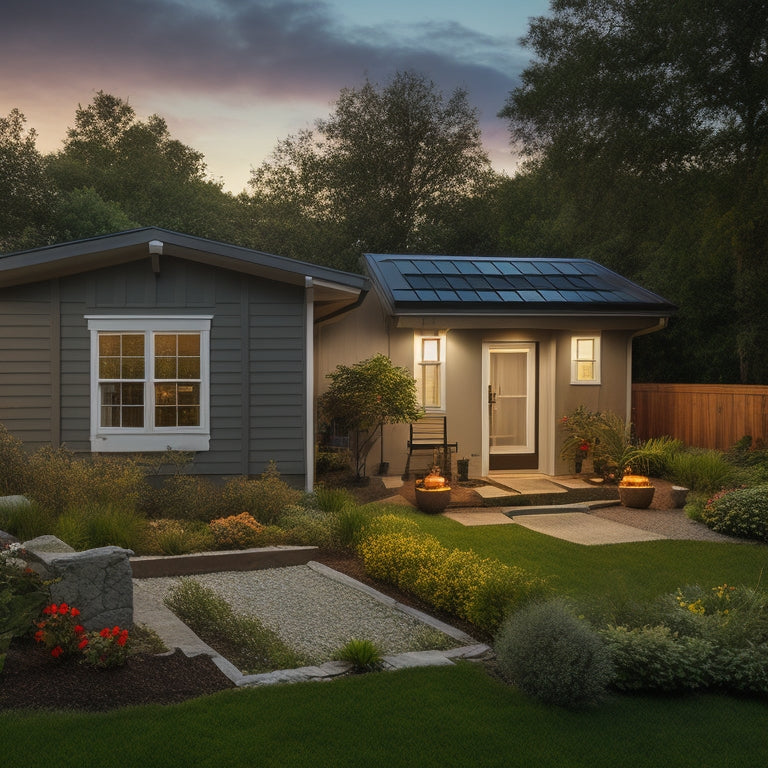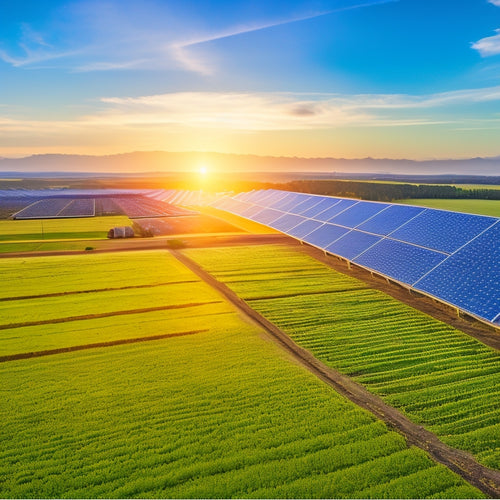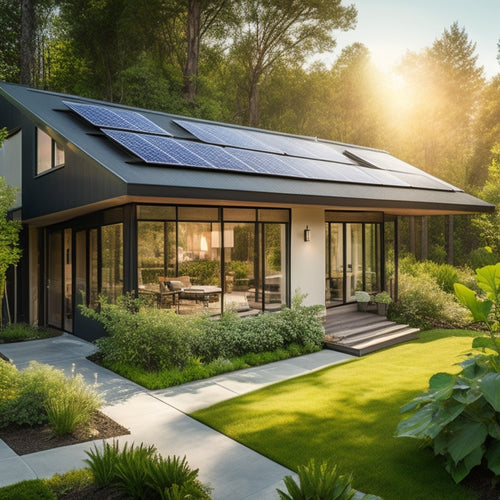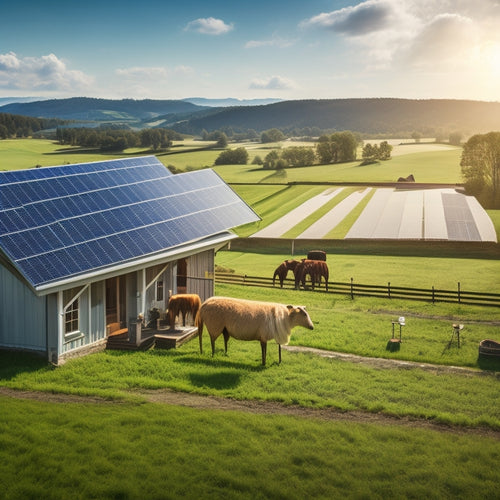
Building a Home Solar System on a Budget
Share
You can build a home solar system on a budget by first evaluating your energy needs, identifying areas for improvement, and optimizing your energy management. Then, choose affordable solar panels by considering their efficiency, durability, and warranty alongside their cost per watt. Select a compatible inverter that matches your solar panel configuration and can handle system voltage. Installing the system yourself can save you money, but weigh the cost savings against the potential risks and warranty implications. By making informed decisions, you can optimize your system's energy output and take advantage of available incentives, and by exploring these factors further, you'll be well on your way to creating an efficient and cost-effective home solar system.
Key Takeaways
- Assess energy needs by monitoring consumption, peak usage times, and lifestyle habits to optimize energy management and system sizing.
- Choose affordable solar panels by balancing efficiency, cost per watt, and warranty, considering space constraints and pricing trends.
- Select a compatible inverter that matches the solar panel configuration, system voltage, and offers monitoring features for performance insights.
- Consider DIY installation vs. professional, weighing cost savings against skill level, warranty implications, and project planning complexity.
- Research and utilize available incentives, such as federal tax credits, state and local rebates, and utility company benefits to maximize cost savings.
Assessing Your Energy Needs
About 30% of your total energy consumption is typically attributed to lighting, appliances, and electronics. Understanding your energy needs is essential to building an effective home solar system on a budget.
Your lifestyle habits, including peak usage times and home appliance usage, greatly impact your energy consumption. For instance, running multiple appliances simultaneously or using energy-intensive devices during peak hours can increase your consumption.
Long-term planning involves considering seasonal variations in energy usage, as heating and cooling systems tend to consume more energy during extreme weather conditions. Monitoring your energy consumption helps you identify areas for improvement and optimize your energy management.
Choosing Affordable Solar Panels
You'll need to balance panel efficiency with cost when selecting affordable solar panels for your home system.
A higher panel efficiency typically means more power output per hour of sunlight, but it also increases the upfront cost.
To make an informed decision, you'll want to analyze the cost per watt of different panels to determine which ones offer the best value for your budget.
Panel Efficiency Matters
When shopping for solar panels, efficiency matters, as it directly impacts the amount of energy your system produces. You'll want to balance efficiency with cost, as high-efficiency panels often come at a premium.
| Panel Type | Efficiency Range |
|---|---|
| Monocrystalline | 18-22% |
| Polycrystalline | 15-18% |
| Thin-Film | 7-14% |
High-efficiency panels are ideal for small roofs or installations with limited space. However, if you have ample space, lower-efficiency panels can still provide sufficient energy at a lower cost. Additionally, consider factors like installation orientation, energy storage, and grid connection when designing your system. Manufacturer reputation, environmental impact, and financing options also play a role in your overall system efficiency. Regular maintenance, performance monitoring, and long-term savings will help you get the most out of your investment. By balancing these factors, you can create an efficient and affordable home solar system that meets your energy needs.
Cost per Watt Analysis
The cost per watt (CPW) of a solar panel is an essential metric to evaluate when selecting affordable options for your home solar system.
You'll want to take into account the CPW when comparing different solar panels, as it directly affects the overall cost of your system. CPW is calculated by dividing the total cost of the solar panel by its wattage output.
When assessing solar pricing trends, you'll notice that CPW has decreased markedly over the years. This decrease is mainly due to advancements in technology and economies of scale in manufacturing.
As a result, you can now find high-quality solar panels with competitive CPW.
When making a wattage comparison between different solar panels, remember that a lower CPW doesn't always mean a better deal.
You should also take into account other factors such as panel efficiency, durability, and warranty.
Selecting a Compatible Inverter
Most home solar systems require a single inverter to convert DC power from the solar panels to AC power for your home. When selecting an inverter, you'll need to evaluate several factors to guarantee compatibility with your system.
You'll need to decide between different inverter types, such as string inverters, microinverters, or power optimizers. Research top inverter brands like Enphase, SMA, and Fronius to ascertain which models meet your system's requirements.
Check the inverter's features, such as maximum power output, efficiency ratings, and installation requirements. Confirm the inverter is compatible with your solar panel configuration and can handle the system's voltage and current.
Compare prices among different models, taking into account the warranty options and grid connection capabilities. Some inverters come with built-in monitoring systems, which can provide useful observations into your system's performance.
When making your selection, prioritize efficiency ratings, as they directly impact your system's overall performance. A higher efficiency rating means more of the DC power is converted to usable AC power.
DIY Installation Vs. Professional
As you weigh your options for installing a home solar system, you'll need to evaluate your DIY skill level and whether it's sufficient to tackle the job.
You'll also want to calculate the cost savings of doing it yourself versus hiring a professional, factoring in elements like labor costs and potential mistakes.
Additionally, you should think about the warranty and support implications of choosing one route over the other.
DIY Skill Level Matters
With your solar system's performance and safety on the line, evaluating your DIY skill level is vital when deciding between a self-installed and professionally installed system.
You'll need to assess your comfort with installation tools, safety precautions, and maintenance tips specific to your chosen solar panel types. Are you familiar with local regulations and grid connection requirements? Can you troubleshoot issues that may arise? If not, a professional installation may be the better choice.
You'll also need to take into account your project planning skills. A well-planned system guarantees ideal energy storage and system monitoring.
If you're unsure about any aspect of the process, it's important to acknowledge your limitations and seek professional assistance. A poorly installed system can lead to reduced energy output, safety hazards, and even void your warranty.
Be honest about your abilities, and don't hesitate to invest in professional knowledge if needed. Remember, a well-installed system is vital for maximizing your energy output and enjoying the full benefits of solar power.
Cost Savings Breakdown
When crunching the numbers, a DIY installation can yield significant cost savings, especially for homeowners who can tackle the project efficiently. By opting for a budget-friendly design and energy storage solutions, you can reduce your upfront costs.
Additionally, exploring solar financing options, such as community solar programs, can help spread the cost over time.
In contrast, hiring a professional installer will increase your expenses, mainly due to labor costs. However, they'll handle installation permits, ensuring compliance with local regulations.
Long-term savings will still be substantial, but the initial outlay will be higher. It's important to weigh these factors against the potential benefits of professional installation, including reduced maintenance costs and access to equipment upgrades.
If you're not comfortable with DIY installation, consider solar lease agreements, which can provide a hassle-free experience.
Ultimately, the cost savings breakdown will depend on your specific situation and priorities. By carefully evaluating your options, you can maximize your savings and achieve a budget-friendly solar solution.
Warranty and Support
You've evaluated the cost savings breakdown and are now considering the installation approach. When it comes to warranty and support, DIY installation and professional installation have distinct differences.
With DIY installation, you're typically responsible for guaranteeing the system is installed correctly, which can void the manufacturer's warranty if not done properly. In contrast, professional installers often provide a workmanship warranty, covering installation-related issues for a specified period. This can range from 1 to 10 years, depending on the installer.
Professional installers also typically offer customer support, which can be extremely helpful when troubleshooting issues or performing routine maintenance. They may provide dedicated phone and email support, as well as on-site visits if needed.
In contrast, DIY installations often rely on manufacturer-provided documentation and online resources for support. When evaluating warranty terms, consider the length of the warranty, what's covered, and the process for filing claims.
Additionally, research the installer's customer support reputation and reviews to verify you're getting the level of support you need.
Maximizing Energy Output Efficiency
Optimizing your solar panel array's orientation and tilt angle is vital to maximizing energy output efficiency. Proper installation can increase energy production by up to 20%.
| Optimization Techniques | Description | Impact on Energy Output |
|---|---|---|
| Solar Tracking | Adjusts panel angle to follow the sun's movement | 10-15% increase |
| Shading Analysis | Identifies and mitigates shading from obstacles | 5-10% increase |
| System Sizing | Selects ideal panel size and number for your roof | 5-10% increase |
In addition to these techniques, regular maintenance is important. You should inspect your system every 6 months, cleaning panels and verifying connections are secure. Performance monitoring will help you identify any issues and make data-driven decisions. When connecting to the grid, confirm you comply with local regulations. Consider energy storage solutions to store excess energy generated during the day for use at night or during power outages. By implementing these strategies, you'll maximize your energy output efficiency and get the most out of your home solar system on a budget.
Incentives and Rebate Opportunities
Your investment in a home solar system can be considerably offset by various incentives and rebate opportunities. As you maneuver through the process of building a home solar system on a budget, it's crucial to examine these cost-saving opportunities.
-
Federal Tax Credits: You can claim a federal tax credit of up to 26% of your total solar system cost. This credit can greatly reduce your tax liability, making your solar investment more affordable.
-
State and Local Incentives: Many states and local governments offer additional incentives, such as rebates, grants, and tax credits. These incentives can vary widely, so be sure to research the specific programs available in your area.
-
Utility Company Incentives and Community Solar Programs: Some utility companies offer rebates or special rates for solar customers. Additionally, community solar programs allow multiple individuals or organizations to share the benefits of a single solar array, making solar energy more accessible and affordable.
Frequently Asked Questions
Can I Install Solar Panels on a Metal or Clay Tile Roof?
You can install solar panels on a metal roof, but guarantee a secure metal roof installation with specialized clips and flashing. For clay tile roofs, you'll need to take into account additional structural support and careful tile removal/replacement for a successful installation.
Will Solar Panels Still Work During a Power Outage?
"Think you're stuck in the dark during outages? Not with solar! You'll stay lit if you've invested in solar energy storage, achieving grid independence - a sweet spot where you generate and store power, unaffected by the grid's whims.
Are There Any Special Permits Required for a Home Solar System?
You'll need to obtain specific solar permits, which vary by jurisdiction, to guarantee compliance with local regulations; research and secure necessary permits before installation to avoid delays and potential fines.
Can I Expand My Solar System in the Future if Needed?
You can easily expand your solar system in the future if needed, as most modern systems are designed for future upgrades, ensuring system compatibility and allowing you to add more panels or inverters as your energy demands increase.
How Often Should I Clean My Solar Panels for Optimal Performance?
Just like a dirty car windshield reduces visibility, grimy solar panels slash energy output! You should clean them every 6-12 months, depending on your location's pollution and weather, to guarantee peak performance through regular solar panel maintenance and cleaning frequency.
Conclusion
You've made it! You've successfully maneuvered the intricacies of building a home solar system on a budget. And let's be real, you're basically a genius now. You've slashed your energy bills to near zero, reduced your carbon footprint to a tiny smudge, and joined the ranks of the eco-elite. Okay, maybe that's an exaggeration, but you get the point - you've made a huge impact. Pat yourself on the back, and enjoy the fruits of your labor (and the savings on your energy bill)!
Related Posts
-

Solar Power for Reducing Carbon Footprint
Solar power is an effective strategy for reducing your carbon footprint. By adopting solar energy, you can cut greenh...
-

Integrating Solar Panels Into Home Design
Integrating solar panels into your home design greatly enhances energy efficiency and lowers utility bills while addi...
-

Solar Power Systems for Rural Properties
Solar power systems offer a reliable and efficient energy solution for rural properties, allowing you to gain energy ...


